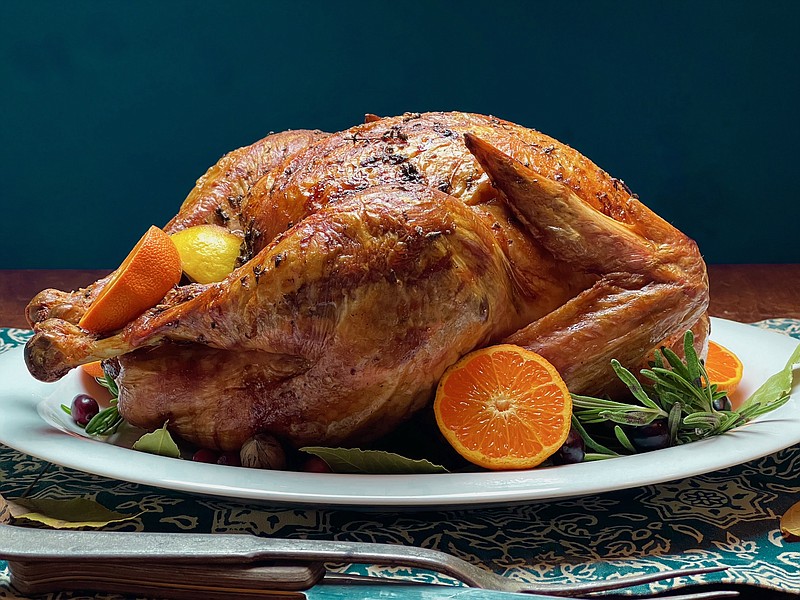Thanksgiving is just over a week away.
If you're planning to serve turkey and you haven't bought yours yet, prepare yourself for some sticker shock.
I paid $1.59 per pound for the 15-pound turkey (the smallest I could find) I bought early last week for this recipe. That was a bargain compared to other turkeys at the same store. Some were as high at $1.99 per pound.
If you think buying just a breast will be a more affordable option, think again. Breasts the day I shopped were priced $2.79 per pound, so even though you're buying fewer pounds, you'll likely end up spending more.
According to a recent USDA National Retail Report (week of Nov. 4-11) advertised whole turkey prices for our region (South Central) ranged from 78 cents to $1.99 per pound. Prices for the same period in 2021 were 77 cents to $1.49. In 2020 the range was 77 cents to $1.38. (If you want to see the data yourself or compare other years, see arkansasonline.com/1116data).
So, no, it isn't your imagination. Just like everything else, this year's turkey costs more.
With the turkey making up a considerable chunk of your Thanksgiving dinner budget, it's important to handle it with care.
The vast majority of Thanksgiving turkeys are sold frozen. You'll need to plan ample time for thawing, plus time for brining, if you plan to brine your bird.
The safest way to thaw a turkey is in the refrigerator, but it takes time. For information on how to quick-thaw a turkey or cook a frozen one, see this column from 2018, arkansasonline.com/1116thaw/.
A frozen turkey will need 24 hours for every 4 to 5 pounds to thaw in a 40-degree refrigerator, plus one day. That means if you have a 15-pound turkey you'll need to transfer it from the freezer to your refrigerator — ideally on the lowest shelf and with a sheet pan underneath to catch any drips — by Sunday morning at the latest. A 20-pound bird will need to go from freezer to fridge by Saturday morning.
If you have a really big bird, go ahead and put it in the fridge now. If your refrigerator runs cold, you might want to add an extra day or two. Once it's thawed, plan on cooking the turkey within four days.
Butter and Herb Roast Turkey
- 1 (12- to 16- pound) turkey
- 2 lemons, divided use
- 1 bunch fresh thyme, divided use (see note)
- 1 bunch fresh sage, divided use (see note)
- ½ cup butter, softened
- 2 sprigs rosemary (see note)
- 1 yellow onion, quartered
- 1 head garlic, halved crosswise
- Kosher salt and ground black pepper
Remove the turkey from its packaging and place it on a wire rack (this can be the same rack you'll roast it on) in a rimmed baking sheet (to catch any drips) and let it sit at room temperature for about an hour.
Meanwhile, position an oven rack on the lowest rung so the breast of the turkey won't be too close to the roof of the oven. Remove the other racks. Heat the oven to 350 degrees.
Remove the zest from 1 of the lemons. Strip 1 teaspoon of thyme leaves from the bunch. Finely chop 1 teaspoon sage leaves.
In a small bowl, combine the softened butter, the lemon zest, the chopped thyme and sage and mix until thoroughly combined. Set aside.
Remove the giblets and anything else you find from inside the turkey, such as the neck and a gravy packet. Remove any excess fat and leftover pinfeathers and pat the outside dry. Return the turkey to the wire rack and place it in a roasting pan.
Cut both lemons in half. Stuff the neck end of the cavity with one or two of the lemon halves and an onion quarter. Stuff the other end of the cavity with the remaining thyme, remaining sage, the rosemary, remaining lemon halves, onion quarters and the garlic. Rub the outside of the turkey with the butter mixture — it will slide off at first but keep massaging, it will eventually adhere — and sprinkle salt and pepper. Tie the legs together with string and tuck the wing tips under the body of the turkey (my turkey came with the legs already bound). Pour some water into the bottom of the roasting pan.
Loosely cover the bird with aluminum foil, shiny side out (to deflect heat) and roast turkey at 350 degrees for 13 minutes to 15 minutes per pound, removing the foil about halfway through, until the internal temperature reaches 160 degrees in the breast and thickest part of the thigh. Add more water to the roasting pan as needed to keep it from becoming so dry that the drippings burn and smoke up your kitchen. A 15-pound turkey will take about 3 hours and 20 minutes total. Tenting with foil keeps the skin from getting too dark too soon. Removing the foil about halfway through cooking lets the skin brown.
Remove the turkey to a cutting board and cover again with aluminum foil; let rest for 20 minutes. The internal temperature will continue to rise while the turkey rests.
Slice the turkey and serve.
Makes 10 to 12 servings.
Note: Can use 2 (.5-ounce) packages poultry herbs.
